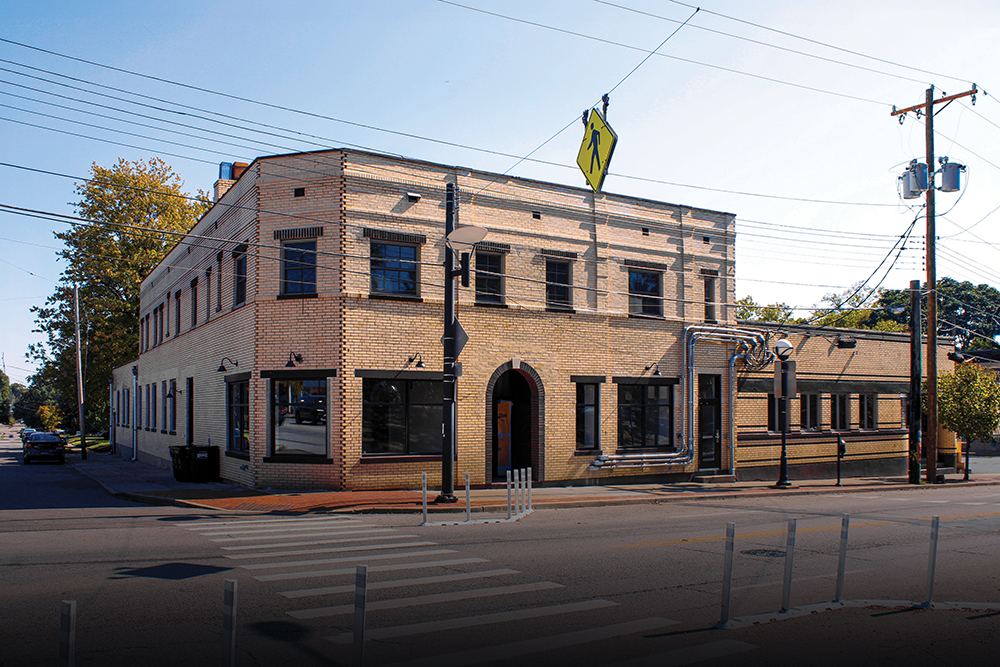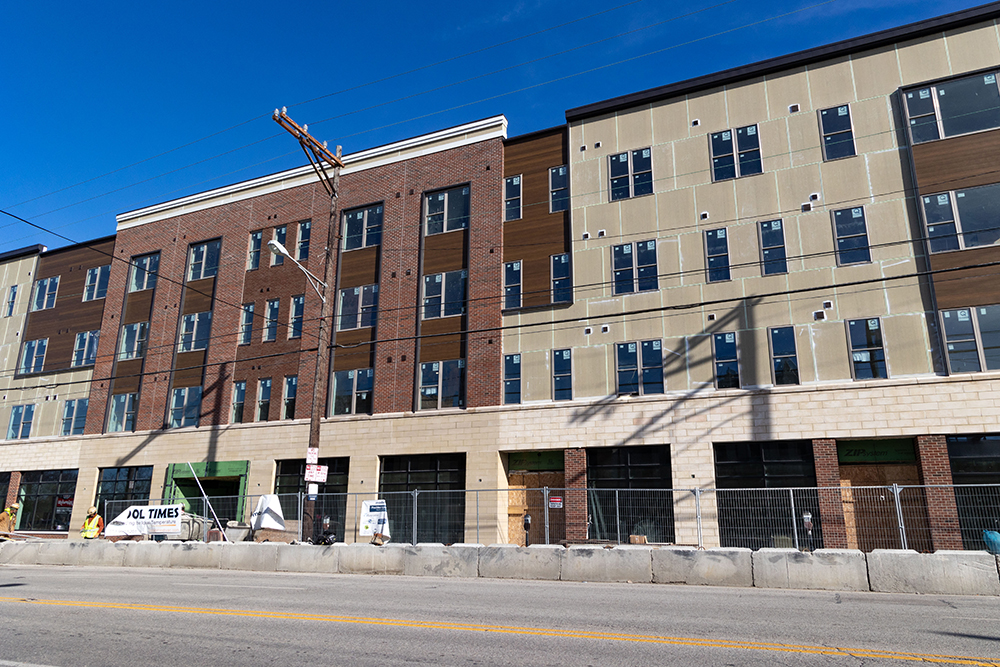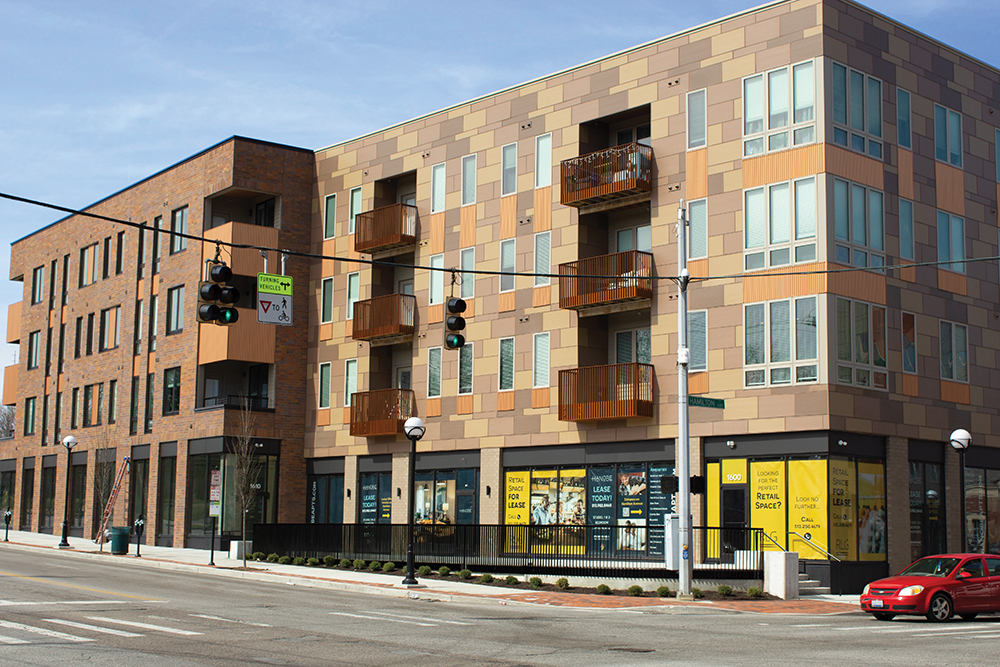Long before Reggie Harris was a Cincinnati City Councilmember, he was a kid riding a bus to his great uncle’s dance studio on Chicago’s South Side. Harris grew up an only child, and he and his mother lived with his grandmother, a widow who had purchased her home through a federal loan program set up for individuals on fixed incomes. Through the years, her house served as a sanctuary for him, his mother, and other relatives who moved in during hard times.
Harris says he thrived on the support of his tight-knit extended family of aunts, uncles, and cousins. He eventually became a professional ballet dancer and later a social worker, earning a bachelor’s degree in psychology and a master’s degree in social work from Boston University. He was elected to council in 2021 and re-elected in 2023 and currently chairs the Budget & Finance Committee.
“It dawned on me that so much of my ability to be the person I am was because I always had access to stable housing,” Harris says in his office in City Hall. It’s a key reason he’s focused his efforts on solving the housing shortage in Cincinnati and why he’s championing a series of proposals that would greatly alter Cincinnati’s zoning, land-use, and parking regulations.
In late January, Harris stood beside Mayor Aftab Pureval and a majority of his council colleagues to announce a series of reforms called Connected Communities. The changes would begin to address the city’s housing shortage, stabilize rents, and facilitate more equitable growth in the city, according to its supporters.

“We are getting in our way of achieving these goals through outdated housing regulations in our zoning code that cap the supply of new housing,” Harris told the room of reporters, city employees, and representatives from various local, regional, and state agencies. “If we stick with the status quo, Cincinnati will be the next city that is completely unattainable to live in for working class Americans.”
The U.S. Department of Housing and Urban Development forecasted a three-year demand of 13,775 for-sale homes and 8,050 rental units in the Cincinnati Metro Area in 2019, meaning the region needed to build approximately 4,600 for-sale homes and 2,700 rental units per year to meet that demand. The Cincinnati region produced roughly 1,500 for-sale units and 3,500 rental units in 2019, but only an estimated 835 were built within the city of Cincinnati itself and development was not equal across city neighborhoods.
Cincinnati is now following the lead of other cities—including Minneapolis, Houston, and Columbus—that found success tweaking or overhauling their zoning codes to ease their own housing shortages. By allowing higher density, Columbus built four times more housing units in 2020 than Cincinnati, according to the U.S. Census Bureau’s Building Permits Survey.
Over the last year and half, Cincinnati’s Department of City Planning and Engagement has been researching and engaging the community to create a new “people-focused” zoning and land-use code, Pureval said in January. The reforms will be voted on by council in late June after another period of community engagement, culminating in a Housing Summit centered on the reforms scheduled for June 11.
“If we want to make wholesome, truly lasting change, we must reform our systems,” said Pureval. “Our plan allows more housing options—not just the most expensive kinds—to be built within a quarter mile of our neighborhood business districts, and along major transit corridors. … Buildings that don’t disrupt the feel of a neighborhood but can allow more Cincinnatians to live near their school, their grocery store, and their bus stop.”

Connected Communities isn’t simply about building more housing—it’s about housing more people within the existing housing stock, allowing higher density in many parts of the city, removing hurdles for developers, and incentivizing construction of affordable housing. The plan takes advantage of existing infrastructure, stabilizes businesses, and supporting transit services, Pureval said.
“Success for us would be having more housing options at different prices throughout the city, so that we are not concentrating poverty and so that our zoning does not contribute to the racial segregation that we’re seeing here today,” he said. “From a number of units perspective, we need more.”
After decades of decline, Cincinnati’s population grew 4 percent between 2010 and 2020 from 296,943 to 309,317, according to the U.S. Census. But from 2017 to 2023, the city experienced a net loss of 3 percent in overall housing units, according to the American Community Survey, and during those years rents rose 24 percent, according to Apartment List rent estimates. In 2022, rents in Cincinnati rose faster than in any other U.S. city.
“Families have struggled to find an affordable, quality home that they can be proud of,” Pureval said in January.
Pete Metz, vice president of civic and regional partnerships at the Cincinnati USA Regional Chamber, says the chamber’s own studies made recommendations consistent with the Connected Communities plan. “One of our strategic pillars is to grow population in a way that allows folks to live in the places that we know have vibrancy and access to opportunity and are connected to a growing transit system,” he says. “Creating that level of certainty and streamlining the whole regulatory process of development through zoning is really important to our members, whether they be nonprofit developers building affordable housing or for-profit developers building mixed-use projects.”
As with many communities across the country, zoning had been used “as an exclusionary tool” in the past in Cincinnati, says Kristen Baker, executive director of the Greater Cincinnati office of the Local Initiatives Support Corporation. LISC is a national organization created by the Ford Foundation and other philanthropic groups in 1979 to address America’s affordable housing crisis. The Cincinnati office opened in 2000.
“We know that there is a large gap in homeownership rates among Black and white residents in Cincinnati,” says Baker. “Zoning changes and allowing for more density has caused a lot of friction at City Hall. It has really zeroed in on the racial injustice that zoning codes can lead to.”
Currently 76 percent of the city’s residential land is zoned for single-family homes even though owning or renting a home is “riddled with barriers for many people,” Harris says.
Cincinnati City Councilmember Seth Walsh saw drawbacks in the current code first-hand when he was executive director of the College Hill Community Urban Development Corporation (CHCURC), which had taken the reigns to develop its six-block business district along Hamilton Avenue. “There’s a business district, but there was no housing there,” he says. “Businesses thrive on Thursday/Friday/Saturday crowds, when people are ready to spend money, but where businesses live or die is on the Monday/Tuesday/Wednesday crowds. Clifton is a great example: There is a lot of density there and a lot of apartments. College Hill just didn’t have that.”
CHCURC solicited opinions from College Hill residents and created a form-based code, which outlined what the neighborhood wanted. It then began to fill in empty lots along Hamilton Avenue and redevelop properties to add housing, including constructing the HaNoBe, a mixed-use development made up of 171 market-rate apartments and 10,530 feet of street-level retail on the northern corners of Hamilton and North Bend avenues (pictured at top). There are also 53 affordable senior housing units at Marlowe Court in the center of the business district, open and fully leased since 2018, as well as renovation projects currently happening at other buildings, including transforming a former bowling alley, Mergard Lanes, into 14 affordable housing units.
In all, College Hill has added 260 new housing units in the business district and an estimated 390 residents, Walsh says, but it wasn’t easy. “It’s exactly what the neighborhood wanted, but the zoning rules required density variances and parking and all the little things—it was an astronomical number of variances. One project alone required more than 200 variances.”
Every variance you seek adds time to a project, he says, and the more time added to the project results in costs going up. “We’re trying to tackle a 20,000-unit affordable housing shortfall right now throughout the city, and if we make it restrictive on the zoning, even though everybody agrees that’s what we need to do, these projects won’t happen.”

After a year and a half of community meetings, surveys, and academic research into what other cities are doing, the city planning department unveiled the Connected Communities proposals in January. First, the plan would legalize what city leaders call the “missing middle,” allowing housing types that fall between detached single-family homes and large-scale, high-density apartment complexes—which includes duplexes, triplexes, rowhouses, and smaller apartment buildings. Homeowners could utilize city programs for home repair dollars, allowing them to earn rental income on a second or third unit and build generational wealth that traditional single-family homes don’t provide, Harris says.

“We are pricing out existing residents to be able to age in place,” Pureval said in January. “It’s no secret at City Hall we are focused on trying to boost home ownership numbers, but specifically home ownership numbers in our Black community that has lagged behind the national average by providing more opportunities like row homes to be built, which are currently illegal in a majority of Cincinnati.”
The proposals are “surgical” changes, Pureval said, recommended for areas that are one-quarter of a mile from each of the city’s 30-plus neighborhood business districts and one-half of a mile from “major transit corridors,” defined as Glenway Avenue, Harrison Avenue, Hamilton Avenue, Reading Road, Gilbert Avenue, and Madison Road.
“Creating more density around the business districts is going to create more demand for the businesses themselves and more housing opportunities, which in the long run should slow down the pace of rent increases,” says Joe Huber, president and CEO of the Cincinnati Development Fund, which has provided loans to community-led real estate projects in the city since 1988, filling a gap not covered by traditional lenders. “We’re not going to just finance a transaction for a financial return for an investor. We need to make sure that anything we’re facilitating is what the community itself wants, whether you’re talking about Avondale, Walnut Hills, or Price Hill.”
Huber likes that the city’s plan is nuanced and follows best practices around the country, adding density but maintaining neighborhood character. “It’s important that the fabric of the neighborhood remains intact,” he says. “In many ways, you’re creating more of what already exists in these neighborhoods. It just hasn’t been allowed to exist for a period of time because of existing zoning restrictions.”
Connected Communities also automatically awards regulatory bonuses to affordable housing projects and creates “places for people not cars” by eliminating or relaxing parking minimums for new construction and redevelopments across the city. “Study after study after study has shown that Cincinnati has enough parking,” Pureval said. “What we don’t have enough of is housing, and often parking is the obstacle to bringing more housing to our community.”
Huber hopes these changes will be a signal to developers not currently operating in the city that Cincinnati is a development-friendly place. “That can help competition among developers and ultimately create more units,” he says. “We love our local developers, and we will always continue to work with them. But I think there’s something to be said for having some more investment come from the outside.”

Huber and others say they were impressed by the city’s coordination with other big regional plans as well as the planning department’s effort to listen to residents. “I’m just impressed with the level of transparency,” says Huber. “This is not something that is being shoved down the community’s throat but built around community input.”
Connected Communities was also designed to dovetail with the city’s Green Cincinnati Plan sustainability plan to combat climate change and with the Reinventing Metro plan, initiated after Hamilton County voters approved a sales tax in 2020 to expand transit service and transit-related infrastructure in the region. “One of the things we know is that transportation is the great equalizer,” Metro CEO Daryl Haley said at the press conference in January. “If you’ve got great transportation in a region, people can live anywhere. They can work anywhere. They have access to healthcare and education and to not just more jobs but higher paying jobs.”
Anyone interested in seeing how the new reforms would impact a specific property can enter an address into the Connected Communities website and find out.
Pureval sees these potential reforms as “a once-in-a-generation opportunity to completely change the face of Cincinnati and make the biggest impact possible for current residents. We will continue to make sure that equity and engagement are front and center. What will come out of this work is a policy that allows more Cincinnatians to live near the places where they live, work, and play.” He encourages anyone who is interested in the details to attend the June 11 Housing Summit.
Metz believes that if you build something that works people will use it, whether it’s the transit system or a more people-focused and equitable zoning code. “We are now building a transit system that works, and I think the same is true about neighborhoods,” he says. “That has borne itself out with all the hard work that community development corporations have done in Madisonville, College Hill, Northside, Price Hill, and Walnut Hills. Connected Communities makes it easier to build those places, and that’s good policy.”
Baker at LISC hopes that, if the reforms pass and the city sees early demonstrations of their efficacy, the changes will be expanded into higher income areas on the East Side not included in this plan.
“The other piece of it, frankly, is wages,” says Baker. Cincinnati region median home value rose from $132,000 in 2016 to $229,000 in 2023, a 73 percent increase, while wages increased just 37 percent over the same time, according to the Zillow Home Value Index. “Prices go up, but our wages don’t keep pace. There’s more opportunity for us to think about the workforce side of this. How do employers step forward and think about their compensation and what they’re doing to help support their workforce?”
Thinking back on his upbringing, Harris says he will continue to push for home ownership reforms so that Cincinnati residents get a fair shake, like he did. “My family really reflects the American Dream generationally because of my grandmother and her home,” he says. “I had the opportunity to grow up in a dense, walkable neighborhood with access to public transit. That’s one part of my origin story and why I recognize the power of housing.”


